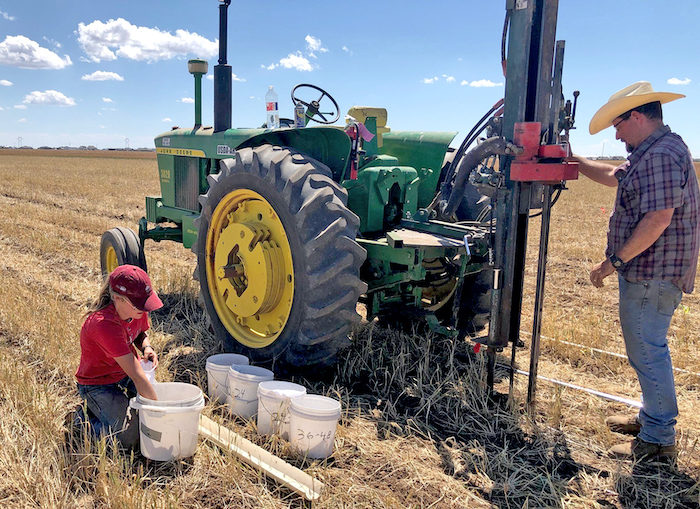In the wake of high fertilizer prices, one thing farmers should do this year more than any previous year is deep soil testing, according to a team of Texas A&M AgriLife Extension Service specialists.
Fertilizer application helps achieve optimum crop yields by supplementing the available plant nutrients already present in the soil and helps meet crop fertility needs. However, producers don’t always consider what is already present in the soil.
“Soil testing can help control high and variable fertilizer costs by determining the most appropriate type and rate of fertilizer needed for each commodity,” said DeDe Jones, AgriLife Extension risk management program specialist in Amarillo.
The AgriLife Extension team published their findings after analyzing the benefits of soil testing before planting corn, cotton or wheat. They found projected savings of anywhere from $8 to $116 per acre are possible by just taking advantage of the residual nitrogen already in the soil and accounting for it when making growing season decisions.
Comprised of specialists in the Texas A&M Department of Agricultural Economics and Department of Soil and Crop Sciences, the team includes Jones, Jourdan Bell, Ph.D., agronomist, and Justin Benavidez, Ph.D., economist, all of Amarillo, and Will Keeling, risk management program specialist in Lubbock.
“This study shows that even small investments or minor operational changes can lead to large financial savings,” Jones said. “We demonstrate how deep soil testing allows producers to take advantage of nitrogen already present in the soil and apply less fertilizer.”
Soil Testing
Agronomists typically recommend soil testing each year, as near to planting time as possible, to assess the availability of nitrogen and other essential nutrients, Bell said.
“Many producers only soil sample the top 0-6 inches, but deep soil sampling to depths of 6-24 inches or deeper, if feasible, should be done whenever possible,” she said. “This allows producers to utilize the nitrogen below the upper 6-inches of soil.”
Bell said in addition to reducing fertilizer input costs, proper nitrogen management in crop production systems can impact the need for and rates of other production inputs.
“For example, in cotton, we know that nitrogen in excess of the crop demand can cause aggressive plant growth, so producers have to be more aggressive with their plant growth regulators program,” she said. “There is both an input and production cost.”
Excess nitrogen can also delay cotton maturity, which can impact growing-day limited cotton regions such as the Texas Panhandle, Bell said. So, it is extremely important that producers are aware of residual nitrogen not just to optimize input costs, but also to optimize production.
“We know residual plant nutrient levels in the soil can vary greatly from year to year based on many factors, including fertilizer application rates, rainfall and irrigation, and the cropping system and plant uptake in the prior year,” she said. “That is why annual sampling is important. Although this was only one year’s worth of data, we want to highlight the potential cost savings that can be achieved through deep soil testing.”
Savings Add Up
While plant growth is dependent on many nutrients, proper nitrogen application is critical. Prices for nitrogen fertilizer products have increased dramatically in recent months due to rising natural gas prices and supply chain disruptions from the COVID-19 pandemic.
The cost of nitrogen in 2022 is 55% higher than in 2021 and more than 200% higher than in 2020.
Corn shows the greatest benefit from reduced fertilization expenses because it has the highest nitrogen application rates, ranging from $29 per acre with a 25% residual to $116 per acre for a 100% residual, Jones said.
Cotton registered the second-highest advantage, with cost savings ranging between $18 and $74 per acre. Wheat shows the least benefit due to low nitrogen application rates compared to the other crops, falling between $8 and $32 per acre.
“Our results show that taking advantage of even relatively low levels of residual nitrogen can make a big difference to the bottom line,” she said. “For example, if a producer applies only 75% of their budgeted nitrogen because testing shows 25% is already in the soil, they can save almost $20,000 on a 1,000-acre irrigated farm.”
Greater levels of residual lead to even bigger savings, reaching a high of $81,570 at the 0% of budgeted nitrogen level or if the soil tests show 100% residual.
“We know, due to significant increases in 2022 production costs, it is well worth spending around $1 per acre for deep soil testing,” Jones said. “With the return on investments that we project, testing is a very smart decision.”







Post a comment
Report Abusive Comment